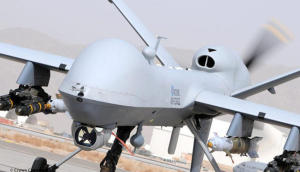
The issue of a President ordering the assassination of a US citizen first hit the presses when Obama authorized a targeted strike against US- born Muslim cleric, Anwar al-Awlaki. The ACLU attempted to derail this revocation of constitutional rights to due process, but the Obama administration prevailed and al-Awlaki was reportedly killed in a drone strike on September 30, 2011. Two weeks later, al-Awlaki’s 16-year-old son, Abdulrahman al-Awlaki, also a U.S. citizen, was killed by a CIA drone strike in Yemen.
The Fifth Amendment to the US constitution reads that no person shall be “deprived of life, liberty, or property, without due process of law.” The Obama administration has responded that an enemy combatant cannot use his citizenship as a shield. The individual now under consideration for assassination via drone strike is reportedly living in a mountainous region overseas.
The Obama administration has declined to release the name of the individual or what country he resides in.
According to reports, the US Department of Justice is currently involved in constructing a case against this individual. This process does not mandate a trial or other Constitutional protections. In his widely reported clarification of his drone policy last year, Obama affirmed that the CIA would not make drone strikes against US citizens. Thus, this potential assassination will be accomplished as a military mission.
Since killing American citizens via drones is now evidently American policy, one must raise the question as to whether or not US citizens living on US soil are protected from this prospect. In a letter by US Attorney General Eric Holder to Senator Rand Paul, dated March 4, 2013, Holder admitted that such an attack on American citizens on US soil was possible. After affirming the excellence of our law enforcement and judicial system in dealing with terrorism, Holder then wrote:
“It is possible, I suppose, to imagine an extraordinary circumstance, in which it would be necessary and appropriate under the Constitution and applicable laws of the United States for the President to authorize the military to use lethal force within the territory of the United States.”
In other words, the use of lethal force, by drones and other military technologies, is on the table domestically.
Recent advances in drone technology make it possible for such a strike to be covert. Drones the size of insects are now in production and in 2012, Time Magazine reported that General Atomics was developing a drone equipped with a laser death ray. Also in development are drones carrying a chemical weapons payload.
While the international Chemical Weapons Convention prohibits countries from using chemical weapons on a battlefield, a loophole allows member countries to use these weapons against their own citizens, via “law enforcement.” In addition, the US has been documented as being in flagrant violation of the Biological Weapons Convention, which opens the door to questions if drones are also being fitted for delivery of biological weapons, as well.
As reported recently in the Bulletin of Atomic Scientists, “…over time we can expect smarter, more capable, and thus more threatening drones. From an engineer’s point of view, the jackpot here will be a smart autonomous drone that can identify targets and destroy them without any humans in the loop.
As of February 2012, Congress enacted the FAA Modernization and Reform Act (P.L. 112-95), which obligated the FAA to accelerate the integration of unmanned aircraft into the national airspace system by 2015. What were once military spy planes, used in conflict zones, are now to become a permanent feature in the US.
We have seen two functions of drones: targeted killing and surveillance. The first US citizen sentenced as a result of intelligence gathered by a drone was reported in January of this year when a cattle rancher from North Dakota, Rodney Brossart, was convicted for terrorizing police officers. Six cows had reportedly wandered onto Brossart’s property near Grand Forks, North Dakota and, when he refused to return the cattle to his neighbor, a SWAT team was called in.
It is of note that Brossart was found not guilty of cattle theft. According to US News and World Report, Bruce Quick, Brossart’s attorney, stated that the use of the drone was illegal because it was “dispatched without judicial approval or a warrant.”
According to the Electronic Freedom Foundation, Customs and Border Patrol Predator drones flew 700 missions over the US in the years between 2010 and 2012 on behalf of the FBI, Immigration and Customs Enforcement, and various local police departments.
Domestically, over sixty agencies have applied for drone authorization, including a number of universities as well as law enforcement agencies.
The US’s war on terror has expanded the concept of a battlefield to include the entire world. Its use of the highly controversial “signature” drone strikes, which result in the targeted killing of those who simply fit a profile rather than constitute a predetermined threat, has upped the ante in terms of whomthe United States decides to kill and under what determination. The use of mechanized and unmanned vehicles to kill American citizens abroad will likely at some point be deployed against Americans at home.
Whether this is termed “mission creep” or a “slippery slope,” one can easily foresee the day when a drone buzzing overhead induces the same terror in American hearts that it is now causing in Pakistan and Yemen.
Janet C. Phelan, investigative journalist and human rights defender that has traveled pretty extensively over the Asian region, exclusively for the online magazine “New Eastern Outlook”.
